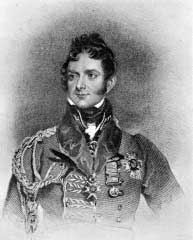Major General Sir Henry Torrens KCB
1822-1828
 Born at Londonderry in 1779 and having been educated at the military
academy in Dublin, he was appointed an Ensign in the 52nd Regiment
in 1793 at the age of fourteen years. He was promoted Lieutenant
in the 92nd Regiment in 1794 and in 1795 was transferred to the
63rd Regiment, then under orders for the West Indies. He was severely
wounded in the right thigh while engaged in the attack on Morne
Fortune in the island of St Lucia in May 1796 while serving with
the army under Major General Sir Ralph Abercrombie. After employment
for seven months at an outpost in the woods against the Charibs
he was promoted to a company in the 6th West India Regiment in March
1797. After a brief spell in England in 1798 he went to Portugal
as Aide-de-Camp to General Cuyler who commanded a body of auxiliary
troops sent by the British to repel the threat of invasion by the
Spaniards.
Born at Londonderry in 1779 and having been educated at the military
academy in Dublin, he was appointed an Ensign in the 52nd Regiment
in 1793 at the age of fourteen years. He was promoted Lieutenant
in the 92nd Regiment in 1794 and in 1795 was transferred to the
63rd Regiment, then under orders for the West Indies. He was severely
wounded in the right thigh while engaged in the attack on Morne
Fortune in the island of St Lucia in May 1796 while serving with
the army under Major General Sir Ralph Abercrombie. After employment
for seven months at an outpost in the woods against the Charibs
he was promoted to a company in the 6th West India Regiment in March
1797. After a brief spell in England in 1798 he went to Portugal
as Aide-de-Camp to General Cuyler who commanded a body of auxiliary
troops sent by the British to repel the threat of invasion by the
Spaniards.
He removed to the 20th Regiment in August 1799 and served with them in Holland where he was wounded, again in the right thigh, by a musket ball. In 1799 he was promoted to Major in the Surrey Rangers who he commanded in Nova Scotia before he returned to England in 1801. He transferred in 1802 to the 86th Regiment then serving in Egypt. After cessation of duties there he went to India, via Cosseir and Bombay, but ill health later forced him on a voyage, intended for England, but which he broke at St Helena where he married the daughter of Governor Patton.
Returning to India he served under General Lord Luke until the conquest of Seindiah the formidable Mahratta Chief. On 1st January 1805 he was promoted to the brevet rank of Lieutenant Colonel and later in the year he returned to England where he became Assistant Adjutant General in the Kent District before transferring to the 89th Regiment in February 1807. Later in the same year he took part in an expedition against the Spanish colonies on the Rio de la Plata and was present in the disastrous attack upon Buenos Ayres on the 5th July 1807.
On returning to England he was appointed to the prestigious position of Assistant Adjutant General and subsequently to be Assistant Military Secretary to His Royal Highness The Duke of York, the Commander-in-Chief. In July 1808 he embarked with the expedition for Portugal under the orders of Lieutenant General Sir Arthur Wellesley and was present at the battles of Roleia and Vimiera. He returned to England with Sir Arthur Wellesley at the end of 1808 and resumed his former duties with the Duke of York. Again transferring, he was appointed to a company of the 3rd Foot Guards in June 1811.
Further promotions and appointments followed including Aide-de-Camp to the Prince Regent with the rank of Colonel in 1812, and that of Major General in 1814. Recognition of his services resulted in his being enrolled in the list of Knights Commander of the Bath in 1815. In the same year he was appointed to the Colonelcy of the 2nd Garrison Battalion in April 1815 and removed to the Royal African Colonial Corps in the following November. After further overseas service with the Second West India Regiment in 1818 he became Adjutant General to the Forces in 1820. Although excessive labours took a toll of his health, his exertions never lessened and his works included “Regulations for the Exercise and Field Movements of the Infantry of the Army”. He was promoted to the Second, or Queen’s Royals, on 26th July 1822 and died suddenly on 22nd August 1828 at Welwyn, Herts.
« Previous ![]() Back to list
Back to list ![]() Next »
Next »
